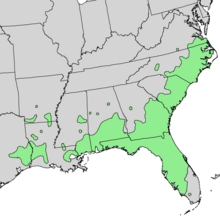bio.wikisort.org - Plant
Fraxinus caroliniana, the pop ash, Florida ash, swamp ash, Carolina ash, or water ash, is a species of ash tree native from Cuba through the subtropical southeastern United States from southern Virginia to Texas. It was originally described by the botanist Philip Miller. It is a small tree about 40 ft. Leaves are compound, opposite, 7–12 in long, leaflets 5–7 in, ovate to oblong, coarsely serrate or entire, 3–6 in long, 2–3 in wide. Fruit is frequently 3-winged (samara) with flat seed portion; seed sometimes a bright violet color. It is the smallest of eastern North American ash species, wood light, soft, weak, 22 lbs./cu.ft. Typical to coastal swamps and subtropical lowlands. Like other species in the section Melioides, Fraxinus caroliniana is dioecious, with male and female flowers produced on separate individuals.[2]
The tree is threatened by the emerald ash borer, an invasive species of beetle.[3]
Climate Change and Swamp Ash
Flooding
Along the lower Mississippi River, flooding occurs during winter and spring. The trees are able to withstand the seasonal flooding.[4] However, flooding has intensified due to climate change. The National Oceanic and Atmospheric Administration found the 2019 spring floods along the Mississippi River were among some of the costliest in history.[5] Lee Jones of J. M. Jones Lumber Company says “The river has been up for so long, and for so much, that it’s killed a lot of the trees”.[4]
Future Concerns
The emerald ash borer are an invasive species from Asia.[4] The beetles damage the trees by boring holes into the wood, damaging the trees' water and nutrient transport system. These beetles have spread to 35 U.S. states and five Canadian provinces.[4][6] The emerald ash borer has not yet reached the lower Mississippi, but Jennifer Koch, a Forest Service biologist, says “it’s only a matter of time” before it affects the swamp ash[4].
References
- Westwood, M.; Oldfield, S.; Jerome, D.; Romero-Severson, J. (2017). "Fraxinus caroliniana". IUCN Red List of Threatened Species. 2017: e.T63004A96445289. doi:10.2305/IUCN.UK.2017-2.RLTS.T63004A96445289.en. Retrieved 12 November 2021.
- Wallander, Eva (2008). "Systematics of Fraxinus (Oleaceae) and evolution of dioecy". Plant Systematics and Evolution. 273 (1–2): 25–49. doi:10.1007/s00606-008-0005-3. S2CID 24152294.
- "Fraxinus caroliniana (Carolina Ash, Florida Ash, Pop Ash, Poppy Ash, Swamp Ash, Water Ash) | North Carolina Extension Gardener Plant Toolbox". plants.ces.ncsu.edu. Retrieved 2020-09-28.
- Runwal, Priyanka. "Climate Change Hits Rock and Roll as Prized Guitar Wood Shortage Looms". Scientific American. Retrieved 2020-10-29.
- "2010-2019: A landmark decade of U.S. billion-dollar weather and climate disasters | NOAA Climate.gov". www.climate.gov. Retrieved 2020-10-29.
- "Emerald Ash Borer". www.emeraldashborer.info. Retrieved 2020-10-29.
На других языках
- [en] Fraxinus caroliniana
[es] Fraxinus caroliniana
El bufano de Cuba[2] (Fraxinus caroliniana) es una especie de árbol de la familia Oleaceae. Fue descrito por el botánico Philip Miller.Другой контент может иметь иную лицензию. Перед использованием материалов сайта WikiSort.org внимательно изучите правила лицензирования конкретных элементов наполнения сайта.
WikiSort.org - проект по пересортировке и дополнению контента Википедии


